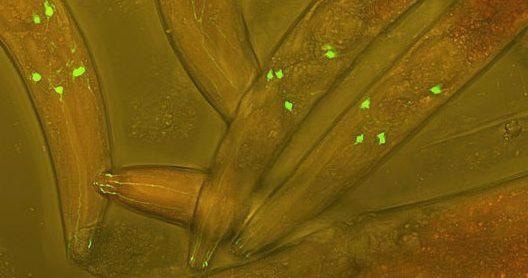Geosmin has a distinct smell that pervades the air after a summer rainstorm or fills your nose when gardening. It smells like moist dirt—earthy and somewhat comfortable.
 Image of c. elegans by Heiti Paves via Wikicommons. Image Credit: Concordia University.
Image of c. elegans by Heiti Paves via Wikicommons. Image Credit: Concordia University.
However, as a recent study in the journal Applied and Environmental Microbiology reminds that smell has a specific purpose. It is produced by bacteria that are well-known toxin makers. This serves as a warning to C. elegans, a popular species of worm, that the bacteria they are going to eat is toxic.
The chemical is an aposematic signal that activates the blind worm’s sense of taste, just like the bright colors of a caterpillar or the spines of a pufferfish warn a sighted predator to keep away.
Nematodes like C. elegans are only a few millimeters long yet may be found all across the world, including Antarctica. Nematodes are also the most common animal on the planet, accounting for around four-fifths of all animals. Because their biological processes are less complicated yet similar to those of humans, researchers frequently employ C. elegans as a model organism in their research.
Through our study, we found that geosmin in Streptomyces coelicolor, a bacteria that is toxic to C. elegans, does not appear to have any role other than as a signal. It doesn’t help the cells grow, eat or divide. It doesn’t ward off predators directly. It just seems to be there as a warning.”
Brandon Findlay, Study Supervising Author and Associate Professor, Department of Chemistry and Biochemistry, Concordia University
Findlay claims he is not aware of any other bacteria-produced compounds that behave similarly.
Liana Zaroubi (MSc 21), a former Findlay student who is currently doing her PhD at Simon Fraser University, led the research.
A scent of danger
Zaroubi admits that she required some time to get to the conclusion that geosmin was aposematic.
It was definitely not obvious, I eliminated many hypotheses before finding that geosmin acted as a warning signal. However, each ruled-out experiment revealed important clues that helped elucidate the mystery that is geosmin. We followed the science and I believe that was key to this discovery.”
Liana Zaroubi, PhD Student, Simon Fraser University
To test this idea, the researchers employed numerous strains of C. elegans. Researchers first studied the movement and behavior of worms on agar plates containing geosmin but no bacteria. In this case, the worms reacted negatively to the compound’s presence by moving quickly and changing directions often.
Mutant nematodes lacking the chemosensory ASE neuron, which is responsible for taste, exhibited normal behavior. C. elegans appears to be unaffected by geosmin.
Streptomyces coelicolor microorganisms were added in a different experiment. When the worms detected the presence of geosmin in their food, the researchers saw them avoiding it. Those without the ASE neurons, on the other hand, devoured the toxic bacteria, killing both predator and prey.
A taste of evolution
Geosmin is an extremely unpleasant chemical that may be detected by humans at a concentration of five parts per trillion. While many people enjoy its odor, it is a bacteria-created contaminant in human drinking water that may make water taste like dirt.
The full scope of geosmin’s biological use is still unknown. The researchers believe, however, that the molecule can help them understand how bacteria and their predators interact, as well as how sophisticated behaviors like toxin avoidance emerge.
Bacteria that produce deadly toxin warning signals with Brandon Findlay
Bacteria that produce deadly toxin warning signals with Brandon Findlay. Video Credit: Concordia University.
Source:
Journal reference:
Zaroubi, L., et al. (2022) The Ubiquitous Soil Terpene Geosmin Acts as a Warning Chemical. Applied and Environmental Microbiology. doi.org/10.1128/aem.00093-22.